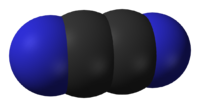- Cyanogen
-
This article is about the chemical compound. For the Android firmware, see CyanogenMod.
Cyanogen 
 EthanedinitrileOther namesCyanogen
EthanedinitrileOther namesCyanogen
Carbon nitride
Dicyan
Dicyanogen
Nitriloacetonitrile
Oxalic acid dinitrile
Oxalonitrile
Oxalyl cyanideIdentifiers CAS number 460-19-5 
PubChem 9999 ChemSpider 9605 
EC number 207-306-5 UN number 1026 ChEBI CHEBI:29308 
RTECS number GT1925000 Jmol-3D images Image 1 - N#CC#N
Properties Molecular formula C2N2 Molar mass 52.03 g mol−1 Density 0.95 g/cm3 (liquid, −21 °C) Melting point -28 °C, 245 K, -18 °F
Boiling point -21 °C, 252 K, -6 °F
Solubility in water 450 mL/100 mL (20 °C) Hazards MSDS ICSC 1390 EU Index 608-011-00-8 EU classification Flammable (F)
Very Toxic (T+)
Dangerous for the environment (N)R-phrases R11, R23, R50/53 S-phrases (S1/2), S23, S45, S60, S61 NFPA 704 Flash point Flammable gas Explosive limits 6.6–42.6% Related compounds Related compounds Cyanogen fluoride
Cyanogen chloride
Cyanogen bromide (verify) (what is:
(verify) (what is:  /
/ ?)
?)
Except where noted otherwise, data are given for materials in their standard state (at 25 °C, 100 kPa)Infobox references Cyanogen is the chemical compound with the formula (CN)2. It is a colorless, toxic gas with a pungent odor. The molecule is a pseudohalogen. Cyanogen molecules consist of two CN groups — analogous to diatomic halogen molecules, such as Cl2, but far less oxidizing. The two cyano groups are bonded together at their carbon atoms: N≡C−C≡N, although other isomers have been detected.[1] Certain derivatives of cyanogen are also called “cyanogen” even though they contain only one CN group. For example cyanogen bromide has the formula NCBr.[2]
Cyanogen is the anhydride of oxamide:
- H2NC(O)C(O)NH2 → NCCN + 2 H2O
Contents
Preparation
Cyanogen is typically generated from cyanide compounds. One laboratory method entails thermal decomposition of mercuric cyanide:
- 2 Hg(CN)2 → (CN)2 + Hg2(CN)2
Alternatively, one can combine solutions of copper(II) salts (such as copper(II) sulfate) with cyanides, an unstable copper(II) cyanide is formed which rapidly decomposes into copper(I) cyanide and cyanogen.[3]
- 2 CuSO4 + 4 KCN → (CN)2 + 2 CuCN + 2 K2SO4
Industrially, it is created by the oxidation of hydrogen cyanide, usually using chlorine over an activated silicon dioxide catalyst or nitrogen dioxide over a copper salt. It is also formed when nitrogen and acetylene are reacted by an electrical spark or discharge.[4]
Paracyanogen
Paracyanogen is produced by polymerization of cyanogen through pyrolysis of heavy metal cyanides.[5]
Astronomy
Cyanogen is used to measure the temperature of interstellar gas clouds[6].
History
Cyanogen was first synthesized in 1815 by Joseph Louis Gay-Lussac, who determined its empirical formula and named it.[7] It attained importance with the growth of the fertilizer industry in the late nineteenth century and is still an important intermediate in the production of many fertilizers. It is also used as a stabilizer in the production of nitrocellulose.
Safety
Like other inorganic cyanides, cyanogen is very toxic, as it undergoes reduction to cyanide, which binds more strongly than oxygen to the cytochrome c oxidase complex, thus interrupting the mitochondrial electron transfer chain. Cyanogen gas is an irritant to the eyes and respiratory system. Inhalation can lead to headache, dizziness, rapid pulse, nausea, vomiting, loss of consciousness, convulsions, and death, depending on exposure.[8]
Cyanogen produces the second hottest known natural flame (after carbon subnitride) with a temperature of over 4525 °C when it burns in oxygen.[9]
See also
References
- ^ Ringer, Ashley (Jan 15). "Low-lying singlet excited states of isocyanogen". International Journal of Quantum Chemistry (Wiley) 106 (6): pp. 1137–1140
- ^ Hartman W. W.; Dreger, E. E. "Cyanogen Bromide" Organic Syntheses, Collected Volume 2, p.150 (1943).http://www.orgsyn.org/orgsyn/pdfs/CV2P0150.pdf
- ^ T. K. Brotherton, J. W. Lynn (1959). "The Synthesis And Chemistry Of Cyanogen". Chemical Reviews 59 (5): 841–883. doi:10.1021/cr50029a003.
- ^ A. A. Breneman (1959). "Showing the Progress and Development of Processes for the manufacture of Cyanogen and its Derivates (in: THE FIXATION OF ATMOSPHERIC NITROGEN". Journal of the American Chemical Society 11 (1): 2–28. doi:10.1021/ja02126a001.
- ^ Paracyanogen Paracyanogen
- ^ http://www.mendeley.com/research/interstellar-cyanogen-temperature-cosmic-microwave-background-radiation/
- ^ Joseph Louis Gay-Lussac (1815) "Recherches sur l'acide prussique," Annales de chimie, vol. 95, pages 136-231. On page 163 of this article, Gay-Lussac coined the word "cyanogène" from the Greek words κύανος (kyanos, blue) and γεννάω (gennao, I create), because cyanide was first isolated by the Swedish chemist Carl Wilhelm Scheele from the pigment "Prussian blue".
- ^ Muir, GD (ed.) 1971, Hazards in the Chemical Laboratory, The Royal Institute of Chemistry, London.
- ^ Thomas, N.; Gaydon, A. G.; Brewer, L., A. G.; Brewer, L. (March 1952). "Cyanogen Flames and the Dissociation Energy of N2". The Journal of Chemical Physics 20 (3): 369–374. Bibcode 1952JChPh..20..369T. doi:10.1063/1.1700426. http://scitation.aip.org/getabs/servlet/GetabsServlet?prog=normal&id=JCPSA6000020000003000369000001&idtype=cvips&gifs=yes
External links
Categories:- Cyanides
- Inorganic nitrogen compounds
- Inorganic carbon compounds
Wikimedia Foundation. 2010.

